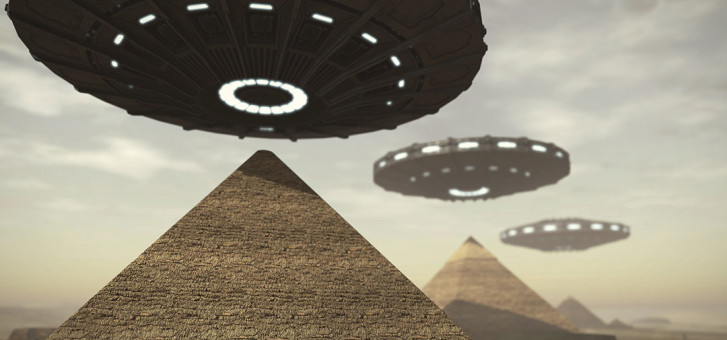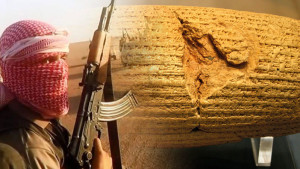Many today believe it was impossible for humans to build such great structures as the Great Pyramids of Giza, something reinforced by dubious claims made on television programs and the internet. Just google “Aliens built the pyramids” and you will discover that many believe aliens were in fact responsible for the construction of these great monuments. While there is no known written record or relief detailing how the pyramids were constructed, there is nonetheless abundant archaeological evidence indicating that the Egyptians themselves were responsible for their building. Evidence for their human construction has been found in the remains of the quarries, roads, tools, records of the workers and the towns in which they lived. We also know why they were built and we can see their lengthy and imperfect evolution before they reached their architectural zenith in the Great Pyramid of Giza. What follows is a highlight summary of the evidence.
The Purpose of the Pyramids
Those who believe that aliens built the pyramids think it a mystery that the Egyptians or any other ancient people could or would build such an immense monument for burying a king. However, we do know why the Egyptians built pyramids.
While being tombs for the pharoahs, the pyramids were also symbols of the ruler's supreme power. Above all, they were monuments to divine Egyptian kingship, where the king would be transformed into a god. Based on an ancient myth, Egyptians believed that at death, kings took on the role of the god Osiris, ruler of the underworld, while their sons took the role of Horus and the kingship. Though deceased, the former king would join the eternal cycle of life to be reborn every day with the sun god. The Egyptians believed that the pyramid facilitated this. Thus, more fundamentally, they were also “resurrection machines,” designed to produce and ensure eternal life. They also legitimised a successor’s rule on the throne, since the pyramid symbolised their father’s new divinity. But why the pyramid shape? And, does that have meaning?
First, pyramids developed from an older form of royal tomb called a mastaba, which were rectangular flatroofed buildings. Under the brilliant architect, Imhotep, a series of mastabas, each one smaller than the previous one, were stacked one on top of another resulting in the form of a stepped pyramid. Second, based on an Egyptian creation myth in which the world was a primeval mound that arose (came into being) out of the waters of chaos, the pyramid, which is a stylised mound, was intended as a place of rebirth.
Since the sun perpetually shines in Egypt, the sun god Re was the supreme deity, and the king aspired to join him in being reborn every sunrise. The pyramid form was shaped like the rays from the sun and its staircase-like form allowed it to serve as the means of ascension. Each pyramid was capped with a pyramidion —a pyramidal stone block. The carvings on the pyramidion of Amenemhat III’s pyramid at Dashur confirm its celestial role for the king, as it is inscribed with a pair of eyes looking up at the sun disk and hieroglyphs that read “Amenemhat beholds the perfection of Re.”
The ancient names for the pyramids reveal their purpose as royal monuments and symbolic locations for the pharaoh’s divine transformation and journey to heaven. The Great Pyramid is called “Khufu’s horizon,” and the other two Giza pyramids are called “Great is Khafre” and “Menkaure is Divine.” Other pyramid names include “Djedefre is a Sehed-Star” and Sahure’s “Rising of the Ba-Spirit.” Being interested in the celestial aspect of the afterlife doesn’t mean the Egyptians were influenced by aliens any more than astronomers are influenced by aliens because they search space with their telescopes.
Pyramids were clearly part of Egyptian religion, forming the focal point for the worship of the deceased king. Rituals involved cleaning, dressing and offering food and drink to statues of the king. Documents such as the Abusir papyri even record the day-to-day activities centred around the pyramids.
Some alien-builder websites claim that pyramids were never used as tombs, however this is definitely incorrect, as some still contain huge stone sarcophagi that were used to hold royal mummies. Funerary texts are even written inside the burial chambers of pyramids built after the Giza ones, and temples attached to the pyramids were used for funeral mortuary rituals.
The pyramid’s purpose is no mystery, since the Egyptians themselves reveal what their purpose was and how they were used and maintained.
Pyramid Building Developed Over Time
It is often claimed by “alien” theorists that the pyramids suddenly appeared out of nowhere. But this ignores clear evidence for the evolution of the form and building process of the pyramids. A number of early pyramids show that the Egyptians got things wrong before they were able to make the great Giza monuments.
The first pyramid was the Step Pyramid at Saqqara. It began as a traditional mastaba for the Third Dynasty king Djoser. Imhotep, the architect, then enlarged the basic structure to be a square and then built a smaller mastaba-like square on top. Inspired by it, Imhotep expanded the building by adding a fourth, fifth and sixth level to eventually form the Step Pyramid.
However, it was not a true pyramid with smooth sides. Other stepped-pyramid projects followed and finally the first attempt at a true pyramid was developed at Meidum for Pharoah Sneferu. It was originally intended to be a seven-step pyramid, but was then expanded to eight steps and completed in the 14th year of Sneferu’s reign. However, in his 28th or 29th year, workers returned to fill out the rest of it into a true pyramid. But, unfortunately, due to constructional deficiencies, the outer casing collapsed.
However, before Sneferu attempted to change the Meidum pyramid into a true pyramid, he began building another pyramid at Dashur, which was the first true pyramid to be intended as such from its beginning. Unfamiliar with building such a structure, construction began at too steep an angle (60°). After severe structural problems were noticed, the architects altered it to a 55° angle as a precautionary measure. Following more problems, it was again changed, this time to a 44° slope, which gives it a bent look, thus leading it to be called the Bent Pyramid.
In order to support their theory, some advocates of the alien hypothesis claim that the Bent Pyramid was a human imitation of the alien-built Giza pyramids. However, the Bent Pyramid is conclusively dated to years 15–30 of Sneferu’s reign and therefore before the Giza pyramids. Since this first attempt at a true pyramid proved too problematic, Sneferu also abandoned it, and started yet another pyramid at Meidum. Learning from the mistakes of his previous attempts, this north pyramid resulted in the first successful true pyramid.
Only after less successful attempts, and experience gained by architects and workers, was the stage set for the construction of the greatest wonders of the ancient world: the Giza pyramids.
How the Egyptians Built The Pyramids
Ancient Egyptians were in a position to build the pyramids because the economy, resources and population of the Egyptian civilisation were all under the control of a single ruler, who could mobilise everyone into a monumental building project. Pyramid building was a complex process carried out over a number of years with many different stages that required enormous resources. However, as will be seen, it was one which the Egyptians were certainly capable of carrying out.
The Great Pyramid of Khufu is made of some 2.3 million stones and is believed to have been built throughout the entire length of the pharaoh’s reign—some 23 years, according to the Turin Papyrus. To achieve this, builders had to lay some 340 blocks each day through an annual workforce of 20,000–30,000 people. The bulk of the stone was more easily moved since it was in the base of the pyramid, covering the largest area. Furthermore the core itself included many irregular stones and debris fill, thus shortening the amount of time needed. There were various building stages:
1. Planning and aligning the Pyramids
The Egyptians planned their buildings with great care and architectural precision. At Amenemhat III’s Hawara pyramid, Rainer Stadlemann discovered a small limestone architect’s model for the pyramid’s innovative substructure, therefore providing evidence that miniature architect’s models were made in similar fashion as today.
An “alien” website claims that only aliens could have aligned the pyramids so accurately with the points of the compass so many thousands of years ago. But they overlook the fact that some Egyptian temple priests devoted all their time to observing the heavens. Incredible precision could be achieved by watching the stars. We know the Egyptians used the stars to assist them in their architectural projects before the Giza pyramids were built, since the ceremony of “stretching the cord,” which is dependent on astronomical knowledge, can be found on a granite block of the reign of the Second Dynasty king Khasekhemwy (2650 BC*). This ceremony was carried out using ropes tied to wooden pegs pounded into the ground. The numerous round holes that have been found cut into the bedrock around the foundations of pyramids and their temples may have been for measuring pegs.
Recently Kate Spence, an Egyptologist at the University of Cambridge, postulated convincingly that the Great Pyramid architects sighted on two stars—b-Ursae Minoris and z-Ursae Majoris —which revolve around the North Pole. These stars would have been perfectly aligned around 2467 BC*, the very date when Khufu’s pyramid was thought to have been built. This theory is supported by the fact that earlier and later pyramids display inaccuracies in their orientation that are in close correlation with the degree to which the alignment of these two stars deviates from true north.
Egyptian architects, surveyors and builders are known to have used the merkhet (the “instrument of knowing,” similar to an astrolabe), the bay (a sighting tool probably made from the central rib of a palm leaf) and plumb bobs.
Archaeologists have also discovered set squares and Pythagorean triangles. All of these instruments would have enabled ancient Egyptian builders to lay out straight lines and right-angles, and to orient the sides and corners of structures in accordance with astronomical alignments. Once the four corners had been plotted, the Egyptians aligned the straight sides by stretching a rope between each corner in the “stretching of the cord” ceremony. Buildings much older than the pyramids were laid out using a unit called a cubit (about 52.5 cm). The angle of inclination of the pyramid’s sloping faces was calculated by the Egyptians using a simple and precise method as seen in the Rhind Mathematical Papyrus.
2. Quarrying
A limestone quarry, located on the Giza plateau, 300 m (985 ft) south of the Great Pyramid, reveals that local limestone was used for the pyramid core. The quarry reveals how the blocks were cut out. In the quarry are the stumps of approximately 3- x 3-m blocks removed thousands of years ago. Trenches are found between them where the stonecutters would have worked. Blocks of stone were cut by pounding channels into the limestone using hammer stones to separate them from bedrock. These channels are clearly visible even today. The blocks were then detached using large wooden levers. Near the Sphinx, and in Menkaure’s quarry, can be found a number of unfinished quarry blocks that are almost detached from the bedrock. Huge lever sockets are also visible in Menkaure’s quarry.
The outer casing of the Great Pyramid was made from finer limestone and granite that were transported by boat via the Nile from Tura and Aswan, while the king’s chamber was made entirely from blocks of Aswan granite. Tool marks preserved on many soft-stone quarry walls (e.g. the sandstone quarries at Gebel el-Silsila) indicate that some form of pointed copper alloy pick, axe or maul was also used during the Old and Middle Kingdoms. Mallet-driven pointed chisels were used from the Eighteenth Dynasty onwards. However this technique would have been unsuitable for quarrying harder stones such as granite. Workers in Old Kingdom quarries probably simply prised large boulders of granite out of the sand. From the Eighteenth Dynasty, granite was cut from Aswan quarries. Unknown tools were used to cut the edges of the granite block that was to be extracted. Workers then cut slots in the bottom of the holes using the same tools. Wooden pegs were then rammed into the slots and filled with water. As the water expanded the pegs, the stones splintered off. An unfinished obelisk still sitting at an ancient quarry in Aswan reveals this process.
Archaeologists have also discovered that the pyramids show human construction in their flaws: The outer shell has very fine polished limestone laid with great accuracy in its joints, while the inner core was very sloppy, with stones not accurately joined at all, and pebbles, cobbles, broken stones and large amounts of gypsum mortar jammed down between the large spaces between the stone blocks.
Fragments of tools, tool marks in the stones and bits of pottery characteristic of the Old Kingdom period were found in many places, even in the largest of the Giza pyramids, again revealing construction by humans.
3. Labour Used
There is abundant evidence left of the people who performed the work of building the pyramids. In recent years Egyptologist, Mark Lehner, discovered a city of the pyramid builders on the Giza plateau, complete with bakeries; institutional buildings; a building for working copper (the hardest metal known to the ancient Egyptians, and used in tools for quarrying and dressing stones); long corridor-like rooms (the Gallery Complex) for sleeping 1600–2000 workers; a site for the processing or consuming of fish; and huge quantities of cattle, sheep and goat bones—“enough to feed several thousand people, even if they ate meat every day,” said Lehner.
Even the tombs of workers who constructed the pyramids have been discovered. The city and tombs demonstrate that the pyramids were built by paid labourers rather than slaves.
Early in the twentieth century, George Reisner found workers’ graffiti that revealed the pyramid builders were organised into labour units with names like “Friends of Khufu” or “Drunkards of Menkaure.” They even graffitied their clearly Egyptian names on the buildings! We now know that the workers were organised into crews of roughly 2000 conscripted peasants, made up of two gangs of 1000. These gangs were divided into five groups of 200 men. Each group was made up of 10 divisions of 20 men.
Some stones from Middle Kingdom pyramids have rough hieroglyphic notes inscribed on them for either scribes or controllers. Such notes consist of the date of transport, the workmen in charge of the block and the stage of transport. Some of the following messages have been written on various stone blocks: “brought from the quarry”; “removal from the quarry”; “delivered at the embankment [or harbour]”; “brought from the embankment”; “delivered to storage enclosures”; “brought” and “dragged” to the pyramid; and, “delivered to the ramp.” Herdsmen, who may have driven oxen that pulled the stone, are also mentioned.
Stones also record the names of the teams responsible for them. Written documents have been discovered that deal with the pyramid builders. Some of the Lahun Papyri detail the dragging of stone blocks by groups of workers involved in building the pyramid of Senwosret II.
4. Transport
While most of the stone blocks were quarried near the pyramid, any finer stone that was quarried from further away was transported via the Nile River by boat. It seems wooden sledges were used to transport the blocks over land as a 4.2-metre-long sledge was found near the pyramid of Senwosret I. A wall painting from the tomb of Djehutihotep (1900 BC) shows a large statue being transported by a sledge. These sledges were drawn by oxen and men, since a number of tomb and temple wall paintings depict the transportation of stones by water and by sledges that are drawn by men or oxen.
Roads and tracks were made for the sledges. Such roads and tracks have been found at Lisht near the Twelfth Dynasty pyramids of Amenemhat I and Senwosret I. The roads at Lisht are up to 12 m (36 ft) in width and were made with a foundation consisting of limestone chips and mortar fill, with wooden beams (spaced like railway sleepers) inserted. Over the top was a layer of limestone chips and white gypsum that provided a smooth, solid surface.
Water was used as a lubricant for the ground to make it easier to pull the sledges. A wall painting from the tomb of Djehutihotep shows a large statue being transported by a sledge with a person on the front of the sledge pouring out water to wet the sand, reducing friction. It is clear that transporting large amounts of stone was well within the ancient Egyptians’ capabilities.
5. Laying the Blocks
When moving stones into place, in order to preserve the exact alignment of the walls, corner blocks were set first. Other blocks were then brought in and moved into their final place using levers. A casing block of Khufu’s pyramid shows a lever hole in the base of the block, which was then filled in with plaster. Since different teams laid blocks from each of the pyramid’s corners, there could be gaps in the middle, which were then filled with smaller blocks. This is clearly seen in the Meidum pyramid.
The Use of Ramps in Pyramid Building
Archaeologists believe ramps were used to drag the blocks of stone to their positions in the pyramids. Some of the step mastabas of the Third Dynasty, which are the proto-pyramids, show evidence that they had ramps on each side. While no ramps have survived at the Great Pyramid itself, traces have been discovered at the Great Pyramid and around other Old Kingdom pyramids. The Meidum pyramid has indications that a ramp was applied to the outer casing. Traces of a “staircase ramp,” which was a steep and narrow set of steps leading up one face of the pyramid, have also been found at the Sinki, Abu Ghurob and Lisht pyramids.
A “spiral ramp” was possibly described in the Nineteenth Dynasty Papyrus Anastasi I. Traces of “interior ramps” have been found inside the remains of the pyramids of Sahura, Nyuserra and Neferirkara, at Abusir, and of Pepi II, at Saqqara.
With the use of such ramps, 50 per cent of the blocks could have been towed to a height of 30–50 m (90–165 ft). These ramps, made from limestone chip, tafla and gypsum, rather than stone blocks, would have been easy to build and dismantle.
Pyramid Building feasible
Many websites display a misunderstanding of the nature of pyramids. One such site states that the pyramid stones are megaton (1 million ton) rocks, which could simply never be moved by humans. The blocks were definitely not a million tonnes each. Rather, on average, they weighed about 2.5 tonnes. Surrounding the blocks with teams of men, using cattle as well, which the Egyptians sometimes used, and wetting the sand would have made the job very doable, since the Nova pyramid-building experiment revealed that 20 men could easily pull a two-tonne block along lubricated tracks.
People assume that since we don’t build such pyramids today, it would have been impossible for the ancient Egyptians to do so. However, in the NOVA pyramid-building experiment it took just 40 days to build a pyramid measuring 6 m (20 ft) high using mainly ancient technologies and a team of just 44 workmen, none of whom had any experience in pyramid building. If this can be done as just an experiment, there is no question that the state-controlled Egyptian system could acquire and organise thousands of workers over a number of years to build a real pyramid.
The Giza Pyramids and astral alignment
Robert Bauval and Adrian Gilbert theorise that the layout pattern of the pyramids is identical to the three belt stars of the constellation Orion. However, in all probability this is just pure coincidence. The belt of Orion is famous in part because of the natural simplicity of its layout. The arrangement of the Giza pyramids in that pattern was probably because it offered the best line of sight. Being laid out in a diagonal line, the pyramids do not block each other.
To strengthen the connection with their Orion orientation theory, however, Bauval and Gilbert, using computer software to find when the alignment of the pyramids would have exactly mirrored the constellation Orion in the sky, claimed this occurred in 10,450 BC, and that this is therefore the date, before Egyptian civilisation, that the aliens built the pyramids. However, while there is absolutely no evidence the pyramids existed before the Egyptians, there is abundant evidence that they are the cultural, religious and political products of the early Egyptian state. The Giza pyramids were built during the Fourth Dynasty, which according to current Egyptian chronology, dates to around 2575–2450 BC.
Radiocarbon dating was carried out on the Great Pyramid several times in the 1980s and ’90s. It was initially funded by the Edgar Cayce Foundation, a group that also wanted the pyramids to date to 10,500 BC, because they believed they were remnants of Atlantean society. While this dating method is not always accurate, the radiocarbon date for the Great Pyramid ranged from 2660 to 3809 BC, so not so far off other reckonings. Dating of a funerary boat found buried beside the Great Pyramid was radiocarbon–dated to about 2600 BC. Thus the pyramid certainly does not date from 10,500 BC.
Clearly there is abundant evidence that the Great Pyramids were built by very human Egyptians rather than by aliens. Interestingly, probably the world’s leading authority on the Giza pyramids today, Mark Lehner, first went to Egypt as a New Age student, intrigued by the mysteries of the “Sleeping Prophet,” Edgar Cayce. As mentioned, Cayce believed the Giza pyramids to be remnants of an Atlantean society and also asserted there was a “hall of records" beneath the Egyptian Sphinx that held the historical texts of Atlantis. However, the longer Lehner worked on the Giza plateau, the more he realised that such notions “could not stand up to the bedrock reality of the Giza Plateau.” Accordingly he turned to an open-minded scientific method of discovery in order to understand the culture better. One can only hope that alien theorists will be as open-minded as Lehner was to the evidence.







